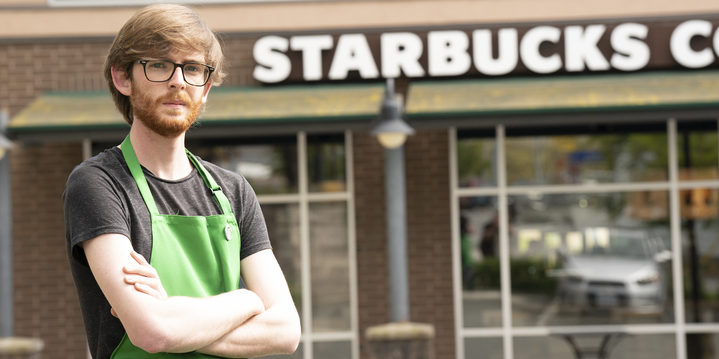Gains are being made in the unionizing effort at different Starbucks locations across Canada after a flurry of activity in the U.S. that saw more than 200 Starbucks locations join unions this year.
A handful of stores in B.C. and Alberta are joining the United Steelworkers (USW) union to win better working conditions. According to a release by the USW, Starbucks workers are joining in hopes of winning higher wages, more paid hours to avoid understaffing and better health and safety measures.
In June, only one Starbucks location in Canada was unionized, according to Canadaland. Now, the USW says they represent Starbucks workers in Calgary, A.B., and Victoria, Surrey and Langley in B.C.
Unionization in retail on the rise
CNBC wrote that Starbucks is not the only corporation in the U.S. that is seeing historic unionization. They wrote that activity is picking up in other retail spaces such as Trader Joe’s. As the number of unionized Starbucks stores in Canada climbs, growing unionization in other retail spaces may be seen as well.
As unionization in retail spaces picks up, it is important to understand what types of barriers exist to building the worker power and solidarity needed to get a workplace unionized.
Statistics Canada reported that in 2021, only 17 per cent of people working sales and service occupations were covered by a collective agreement. This was the third lowest coverage rate after management occupations and natural resources, agriculture and related production occupations.
One factor that may be driving low union coverage rates in sales and service occupations is how part-time workers perceive their workplace, according to Kolton Martin. Martin works for Starbucks and is the union representative at the Victoria Starbucks location represented by USW.
The July Labour Force Survey from Statistics Canada reported the number of full-time and part-time employees in each occupation. Based on these numbers, rabble.ca found that, at 33 per cent, sales and services occupations have the highest percentage of part-time employees.
Part-time employment may discourage unionization
According to the Racial Justice Primer by Justice4Workers, part-time jobs have lower wages and fewer benefits. These types of working conditions can contribute to high turnover. Turnover was one issue that did not encourage enthusiasm for unionizing at Martin’s Starbucks location.
“I’ve definitely run into challenges related to part-time work, just in terms of high turnover,” Martin said. “People don’t feel they’re going to be at the job very long so it just doesn’t matter to them.”
Starbucks was not the only sales and services workplace that ran into these issues related to motivation during their efforts to join a union.
A worker at Indigo, who rabble has agreed to keep anonymous to avoid negatively impacting their early unionizing efforts, said that when they began talking to their coworkers about unionizing, they were able to identify three different demographics that each had specific hang-ups related to unionizing.
This Indigo worker said that one of the big groups of the hires were students who expected to get a full-time job in their field upon graduating. These people had no interest in unionizing for the same reason Martin’s part-time coworkers had, they did not expect to be at their job long and therefore had trouble becoming motivated enough to organize their coworkers.
Martin said that one way to combat this type of mindset is to dispel misinformation and remind people about the motivations behind unionizing.
“We tell them to look at it as something for their coworkers,” Martin said. “Even if you’re not going to be there for a while, I feel like the nice thing to do is support your coworkers in that.”
Martin also pointed out that for workers at the Victoria Starbucks location, unionizing has gleaned benefits for employees, even those who were only planning on working for the company for a short period of time.
Unionization reduced workplace harassment at Starbucks
One big concern for Starbucks employees who wanted to unionize was the level of harassment they were facing from customers.
“We just dealt with an unfair amount of harassment,” Martin said. “The company’s rules on these things aren’t necessarily bad, but getting management to follow those rules and take steps especially against customers was something we really struggled with.”
Martin said that since unionizing, they have seen management better handle harassment towards employees on the floor.
“We have had customers banned from the store that were consistently harassing us and that’s not something that happened before,” Martin said.
Another barrier to unionizing was the fear instilled in workers, Martin said. This was an issue that also popped up for the anonymous Indigo worker. The Indigo worker said that elderly employees were hesitant to take job action and risk retribution since their job at Indigo is often their only source of income.
Martin said the messaging surrounding what unions are seemed to be coming from an anti-union voice.
“Even if someone didn’t know what unions do, they definitely heard that trying to unionize is not something companies like,” Martin said. “That message has gotten through but what unions actually do has not really gotten to many people.”
Martin said that one-on-one organizing was vital to dealing with fear from coworkers. Helping to educate people about their rights and being prepared to mobilize if someone gets unjustly fired for being pro-union were key to helping people overcome their fears related to unionizing, Martin said.
“Just know that a lot of people don’t know what unions are and are scared of the consequences to their boss finding out about their support for a union,” Martin said. “Meet people where they’re at and work with them from there.”



